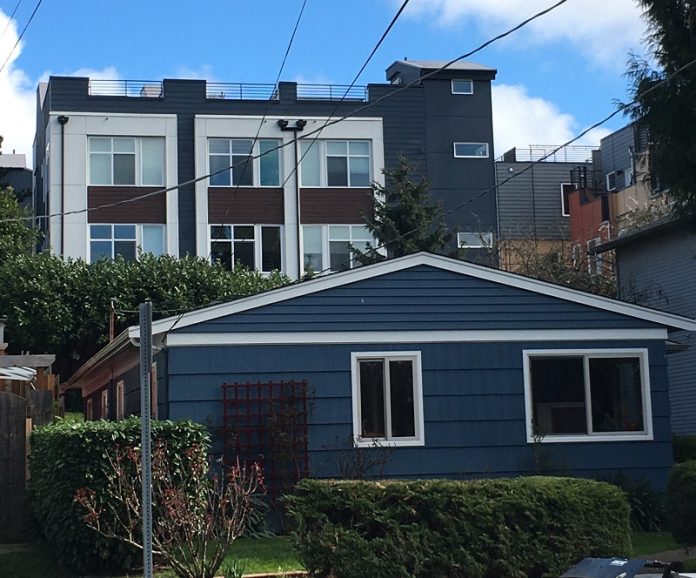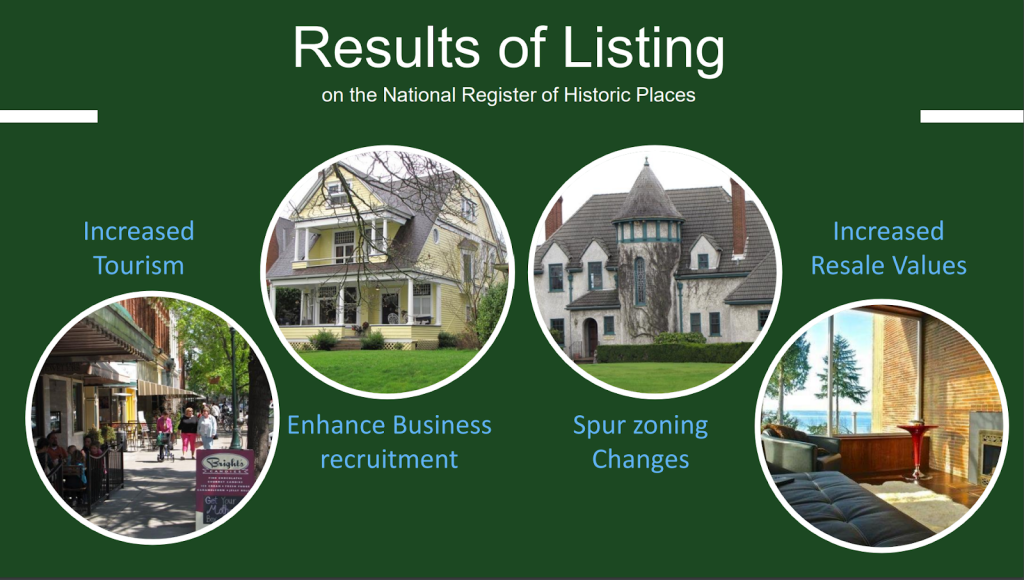
An organization called Historic Wallingford is proposing to have a section of my home neighborhood encompassing more than 600 homes designated as an historic district in the National Register of Historic Places. Their application is scheduled to be heard by the state committee that administers the program in Washington state on October 14.
In 2021, architect Mike Eliason took a look at this proposal as it was being developed, and, writing for The Urbanist, asked: “Are Historic Districts a New Variation to Restrictive Covenants?”
I can’t answer with certainty, but as I learned more about the program since then, I have concluded that the historic designation process itself and its promised effect are clearly incompatible with two values that I want my neighborhood to embrace: affordability and inclusion.
The former is one of if not the most pressing challenges the neighborhood faces. Yet the state agency that administers the program here (the Department of Architecture and Historic Preservation, or “DAHP”) promises “Increased Resale Values” as a result of such a listing.

This would exacerbate arguably the most pressing challenge facing the neighborhood — one which is already costing us long-term neighbors — here’s one such case:
We were renters in Wallingford for over 10 years and just bought our first home in Crown Hill because we couldn’t afford anything in Wallingford despite putting in over five offers on houses listed around 800 that went for 1.3 million.
On the latter point — inclusion — the historic designation process needs to be hauled into the 21st century.
It includes provision for a yea-or-nay vote — but exclusively of property owners. Renters living in the neighborhood have no voice. This strikes me as inappropriate for Wallingford, where a majority of households (62%) are occupied by renters. But it also strikes me as preposterous that a program financed with taxpayer dollars should make property ownership a requirement for full and equal participation in 2022.
This is why I’ve joined hundreds of other current, former, and prospective neighbors as well as others across Seattle in signing an open letter asking that consideration of Wallingford’s National Historic District designation currently pending on October 14 be postponed in order to do two things: create a voluntary, inclusive process for voting and align the timeline with the Seattle Comprehensive Plan update process.
There is nothing that would stop Historic Wallingford from choosing to do the inclusive thing and hold a voluntary, advisory vote that treats renters as first-class citizens too, and then abiding by the results. I also hope that DAHP — which operates with taxdollars paid by renters, not just homeowners — would take a proactive stance recommending that any future applicants for historic district status do the same.
Specific to Seattle and Wallingford, updating Seattle’s Comprehensive Plan is our best opportunity to bend the curve on housing affordability, and it is already underway. Integrating how we choose to commemorate the past with how we choose to shape the future makes sense.
We can even see reasons to believe that creating a more affordable future and celebrating the past could be made to work “better together” already.
Thanks to the Visions of Wallingford project, I learned Kelli Refer’s story. Hers was yet another family renting in Wallingford that faced the prospect of moving away in order to afford home ownership.
Fortunately, they had friends who owned a home here who offered them the chance to build a backyard cottage (technically called a “detached accessory dwelling unit,” or “DADU” — and functionally a “small house”) on their property. It’s an 800 square foot, two story home, sharing the 4,000 square foot lot with the main house. In a win-win, Kelli and her family are responsible by legal agreement for their share of the land, reducing the property tax burden on their friends (DADU’s can also be condo-ized, allowing them to be sold outright).
This is where the Comprehensive Plan update gets interesting: policy choices matter. Thanks to new city rules in 2019, a backyard cottage of up to 1,000 square feet can be built on any neighborhood residential-zoned lot that is 3,200 square feet or larger.
A reasonable ballpark for the cost of construction is $350,000 ($350 per square foot). By comparison, this 1,384 square foot 1916 bungalow on a small lot (2,543 square feet) sold for $1,050,000 in April 2022.

There’s nothing to stop anyone from building a backyard cottage that’s a faithful replica of a classic bungalow. Imagine if the city added a “classic bungalow” to its set of pre-approved DADU plans. Imagine if the neighborhood organized a registry to match renters with some budget — but not a full market rate — budget to buy with homeowners willing to trade some of their yard for a fair, but below market price, provided the DADU is of a classic style.
We could create radically more affordable ownership opportunities by adding new examples of traditional architecture to the neighborhood. (As one yardstick, based on income, a $500,000 mortgage would be considered affordable to a couple of Seattle Public Schools teachers with typical qualifications and about five years of experience.)
By doing things the right way at the right time, I believe this community could find stacked wins across turning a corner on affordability, demonstrating inclusiveness, and sharing knowledge of the past. But there is also a price to doing things wrong.
During the process of proposing that part of their neighborhood be listed as a historic district, a group called “Friends of Ravenna-Cowen” distributed an FAQ. It included this statement: “The National Register has studies that indicate that homes in an Historic District sell for more than comparable homes in other neighborhoods.”
Yet rather than pause to reflect on whether making homes even less affordable might be a bad idea and trying to learn how that might be avoided, and rather than making extra efforts to consider the desires yay or nay of the people with the most skin in the game — renters who hope to own — they went ahead and completed the process.
We can do better.
Historic Wallingford claims that a “principal purpose” is to “raise awareness of the significant cultural values of Wallingford.” It envisions that “elementary, middle, and high school students will benefit from a sense of identity through the identification of a shared past.”
Let’s not create a “shared past” in which a student from a homeowning family and a student from a renting family are going to learn the former’s parents chose to juice their property value at the expense of the latter without so much as a second thought. When and how we choose to celebrate the neighborhood’s past also creates its future — let’s do it right in Wallingford.

Bryan Kirschner
Bryan Kirschner works in technology and lives in Wallingford.
